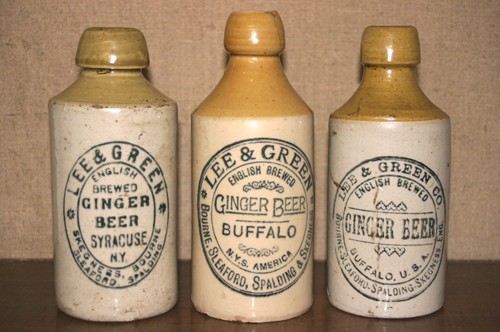|
Lee & Green - the
American connection

by Jonathan Smith
The firm of Lee and Green was
founded at Sleaford by George Raynard Lee and Arthur Green in 1881. The
mineral water bottling enterprise expanded to Spalding in 1886, Bourne in
1891 and Skegness in 1899. In addition to the bottling of superior aerated
waters, the firm also specialised in the production of ginger beer, which
gained Champion status.
Ginger beer of the 18th, 19th and early 20th century was said to have
tasted similar to the best champagne, with sparkling effervescence. No
wonder this favourite drink of England had crossed the Atlantic by 1790.
Ginger beer is fizzy due to the carbon dioxide it contains, a natural
by-product of fermentation, and the alcohol content when produced in the
traditional process can be as high at 11 per cent, although it is possible
to ferment ginger beer so it produces little alcohol. We have no details
of the alcoholic content of Lee and Green's ginger beer.
It was the demand for English brewed ginger
beer in America, particularly around New York, which saw the firm develop
factories in Syracuse and Buffalo in America early in the 20th century.
On 7th March 1900, Arthur Green sailed on the Oceanic for New York to open
a new factory just outside the city, at Syracuse. The firm secured the
services of Nelson Anderson as manager of the branch which was at 113
Raynor Avenue. The opening of a further factory at 344-346 Oak Street,
Buffalo, New York State, followed in 1904.
The American stoneware ginger beer bottles carried a very similar transfer
to the English made bottles used by Lee & Green's Lincolnshire factories
but described it as English brewed, rather than Champion brewed, ginger
beer and in addition to the factories at Sleaford, Spalding, Bourne and
Skegness also carried either the names Syracuse or Buffalo, and in some
cases both American factories. Most of the stoneware bottles used by the
American branches were made there but some were made in this country
by Price of Bristol.
The prospectus published in January 1902, when shares were issued in Lee &
Green Ltd, makes no note of the American branches, just the four centres
in Lincolnshire.
It seems likely that George Lee and Arthur Green continued the American
business as a separate enterprise and it was later
purchased by the Diamond A Ginger Beer Company, which was taken over in
1908 to the Salt City Bottling Company. In 1910, the company moved its
bottling works to 113-1/2 Raynor Avenue which was Lee and Green's building
and the following year built new premises next door at 115 West Raynor.
Lee and Green's Buffalo factory relocated to 52-54 St. Paul in 1910 with
further expansion in 1916 with a move to 932 Ellicot Road in Buffalo. The
business transferred one more time in 1920, to 268-270 Plymouth Avenue and
this was
the company's last year of operation due to prohibition.
Around a dozen variants of ginger beer bottles used by Lee and Green at
Syracuse and Buffalo have been identified by leading American ginger beer
bottle researcher Donald Yates.
Sadly, both in Lincolnshire and America, Lee and Green missed the peak of
ginger beer's popularity. This occurred in America in 1920, when it was
abruptly terminated by Prohibition, and in England fifteen years later, in
1935.
I am grateful to Donald Yates for supplying trade directory details
relating to Lee and Green's branches at Syracuse and Buffalo.
|
BIOGRAPHICAL NOTE: Jonathan Smith has been interested in Bourne's mineral water industry
for more than twenty years
and in 1990 he was responsible for staging the first full exhibition
on the subject at the Heritage Centre
on "Bourne and Its Water Industries" while his collection of more
than fifty mineral water, beer and ginger beer
bottles, from past times is currently on display at the centre.
See also Jonathan Smith |
Return to
The aerated water industry

Go to:
Main Index Villages
Index
|
